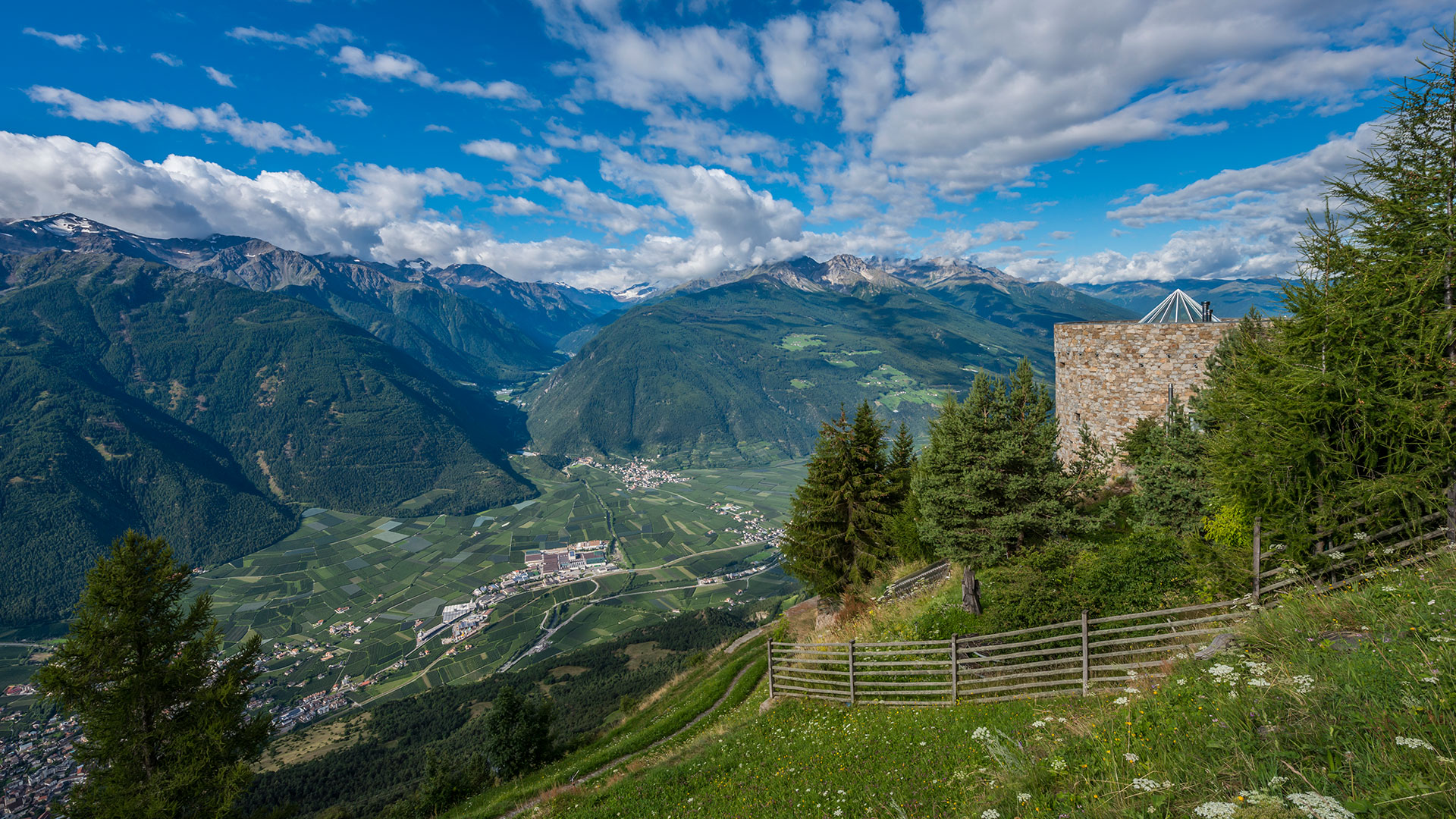
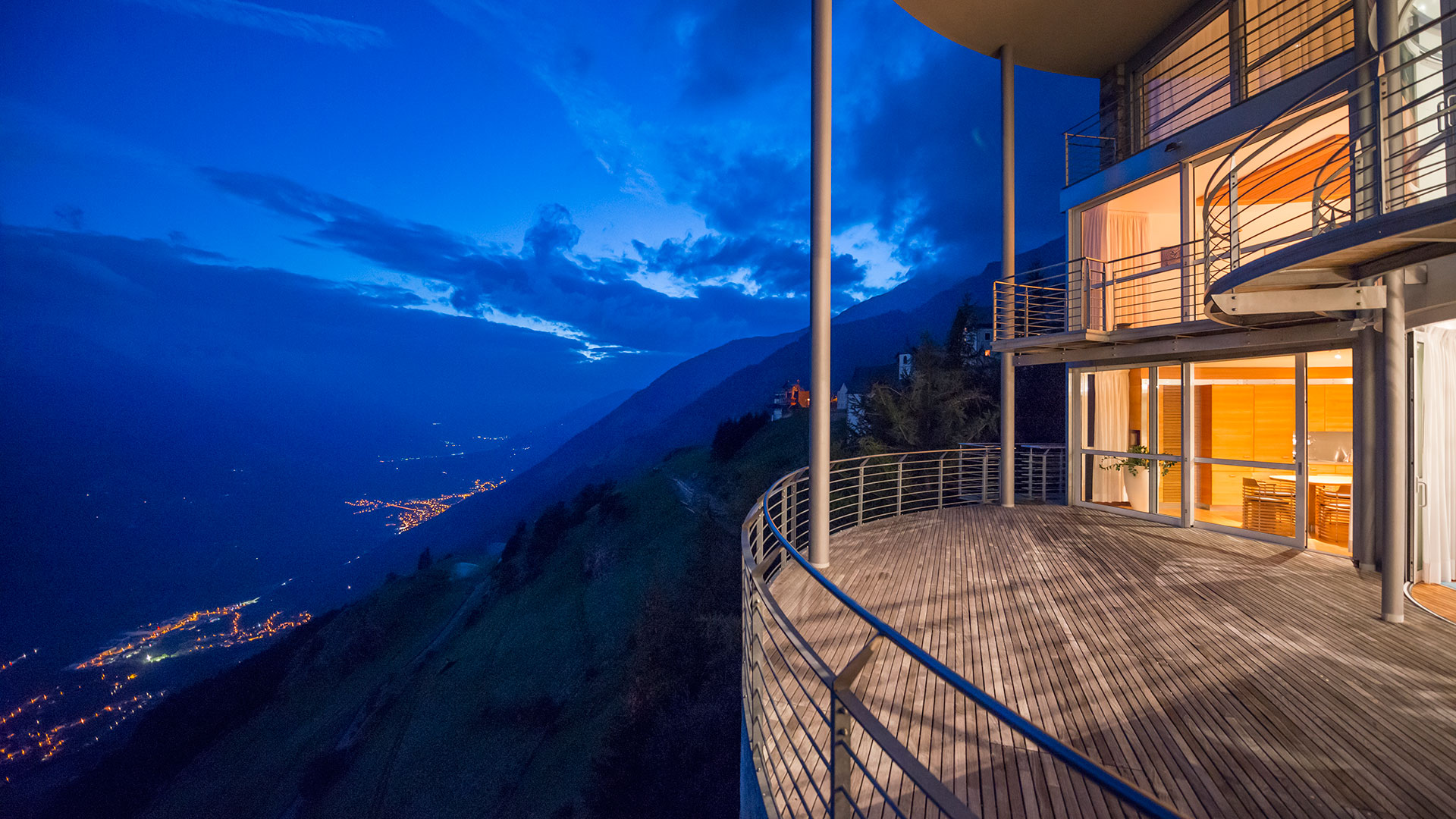
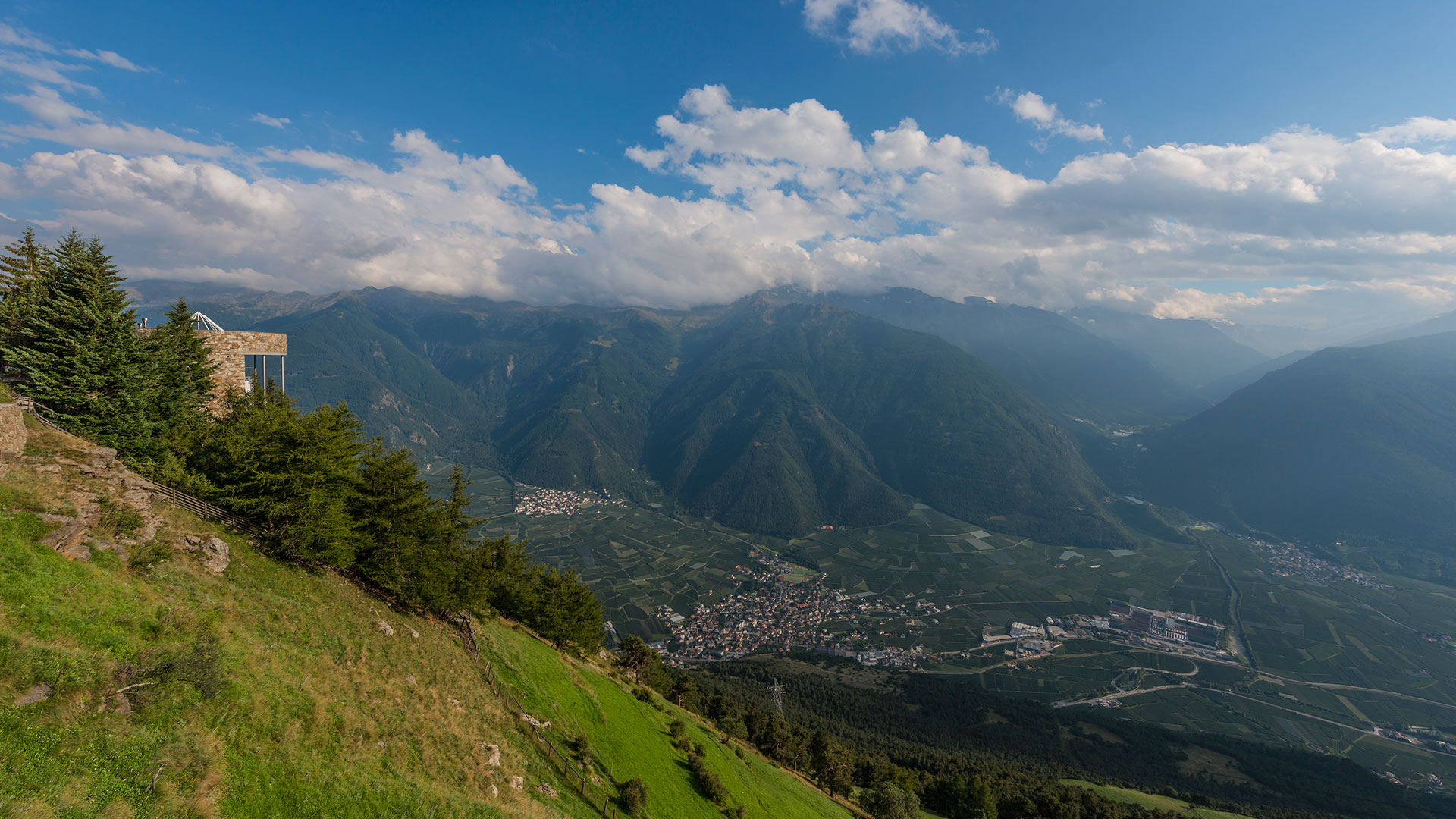
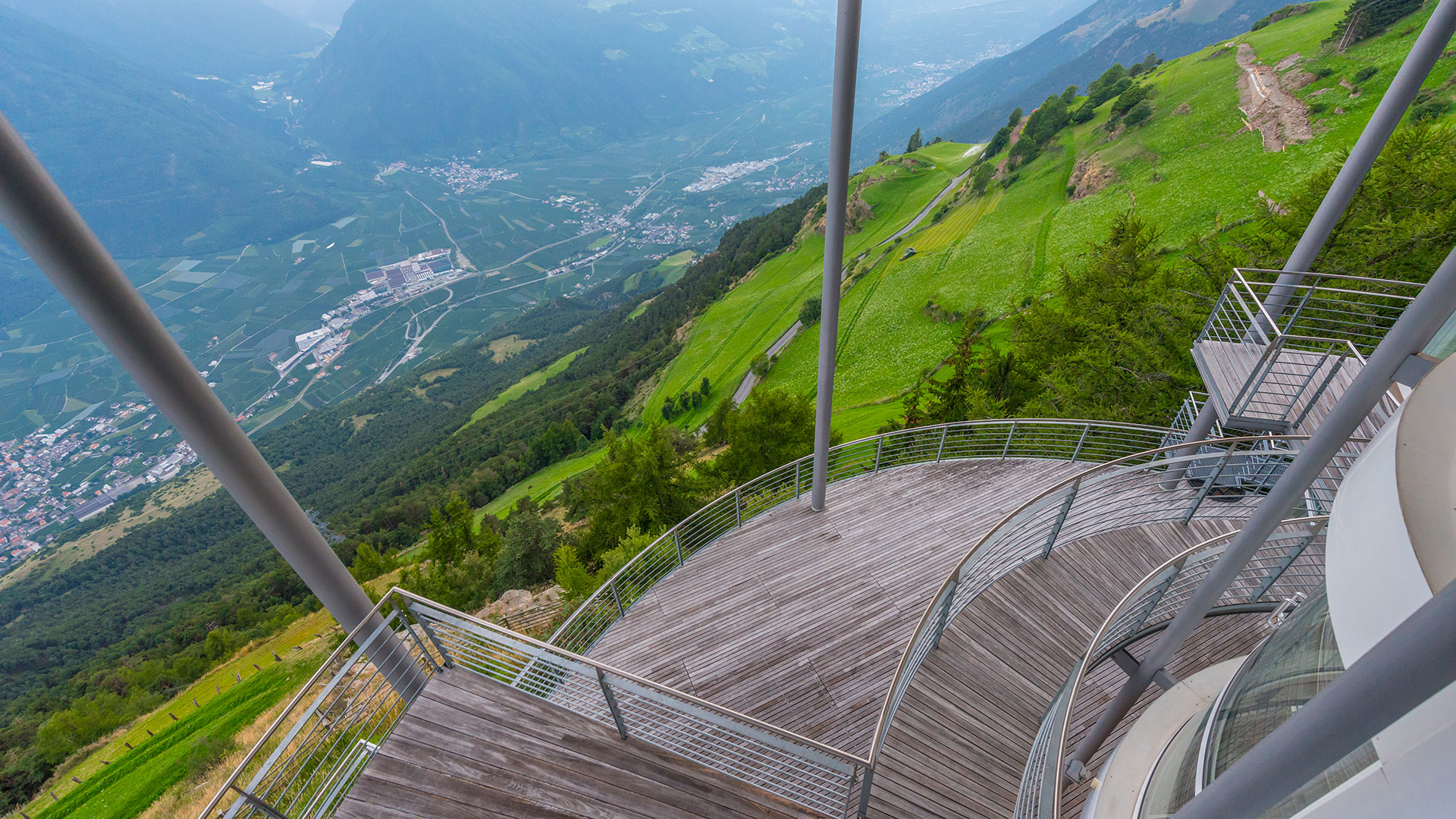
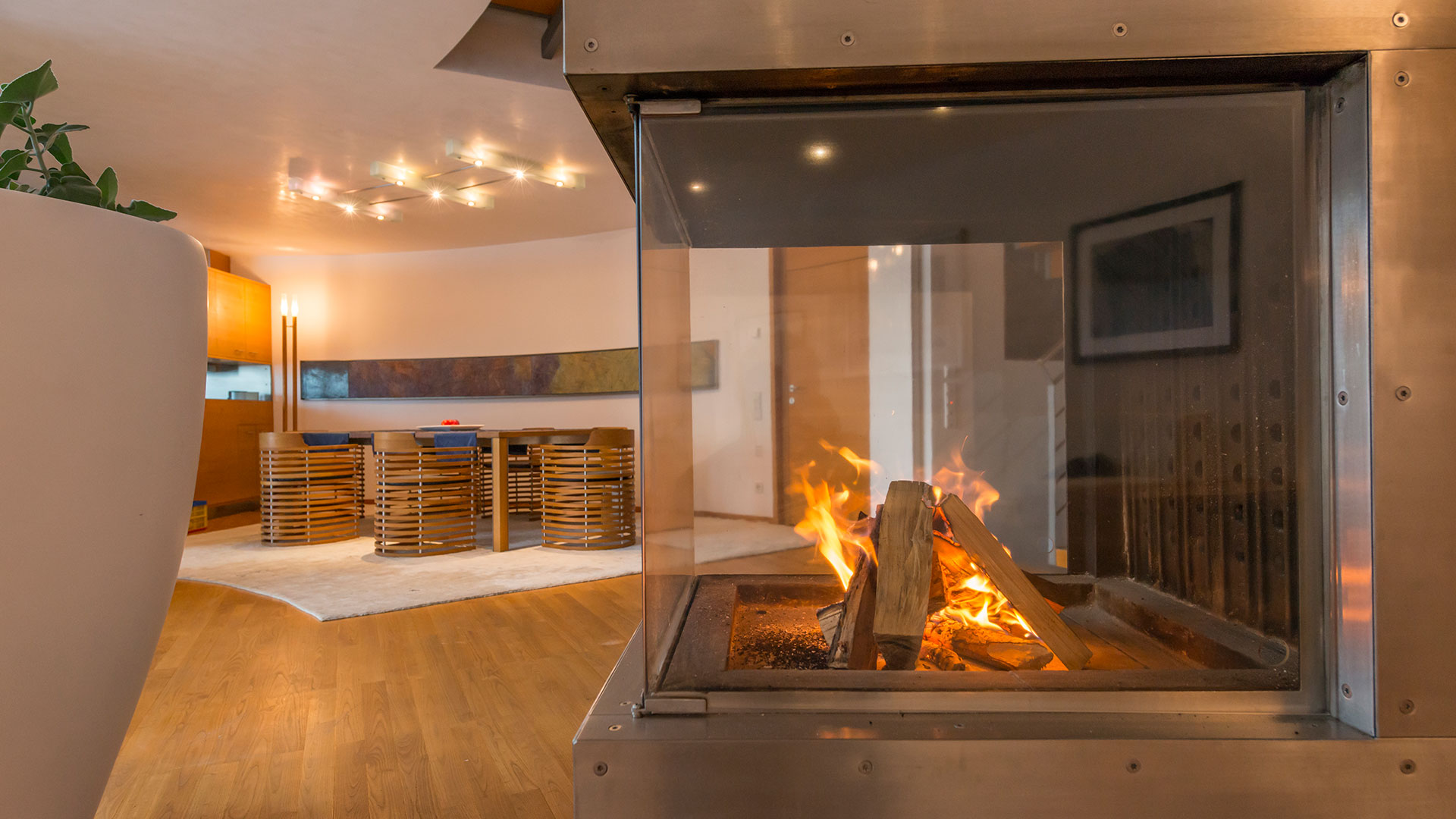
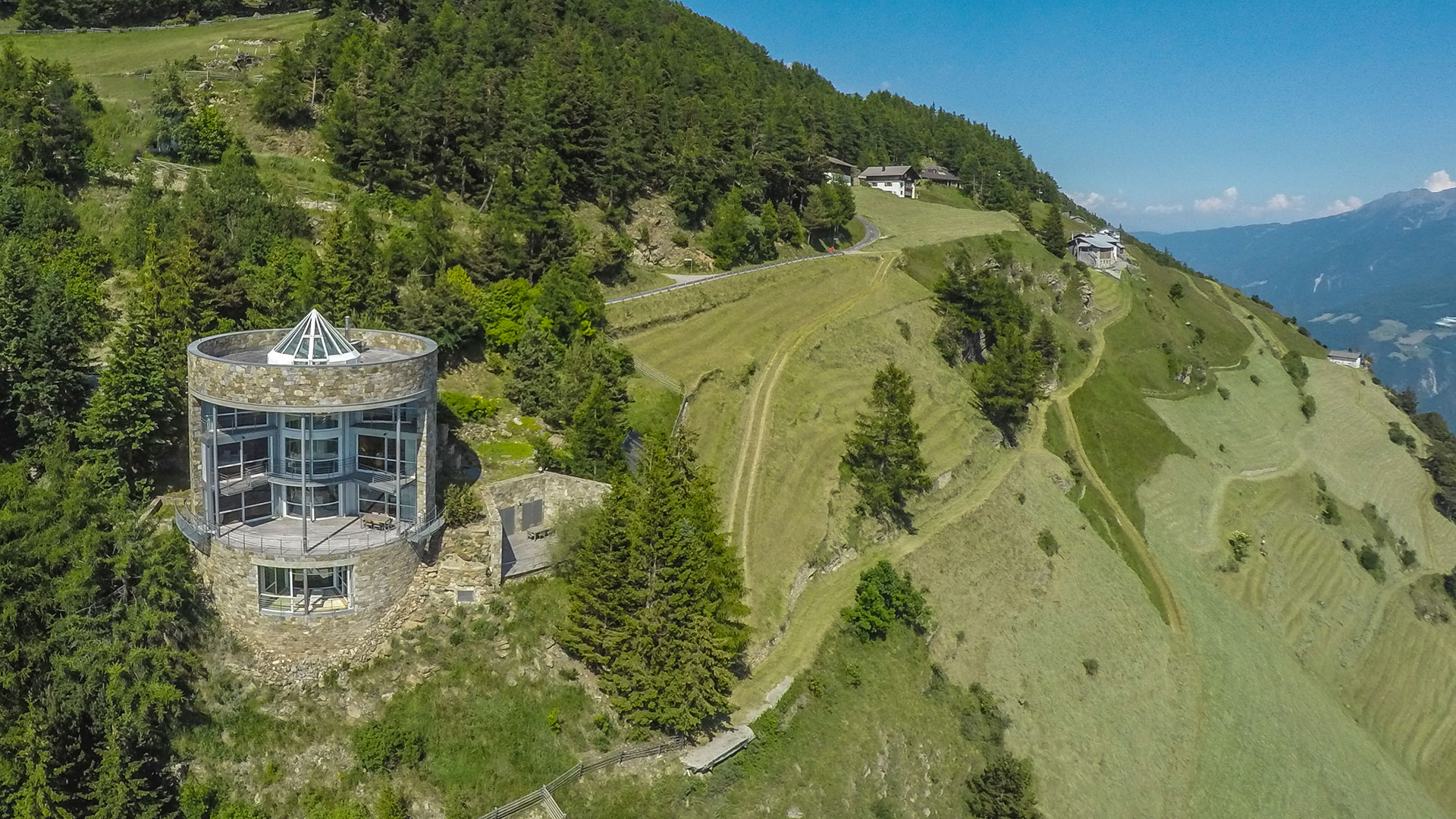

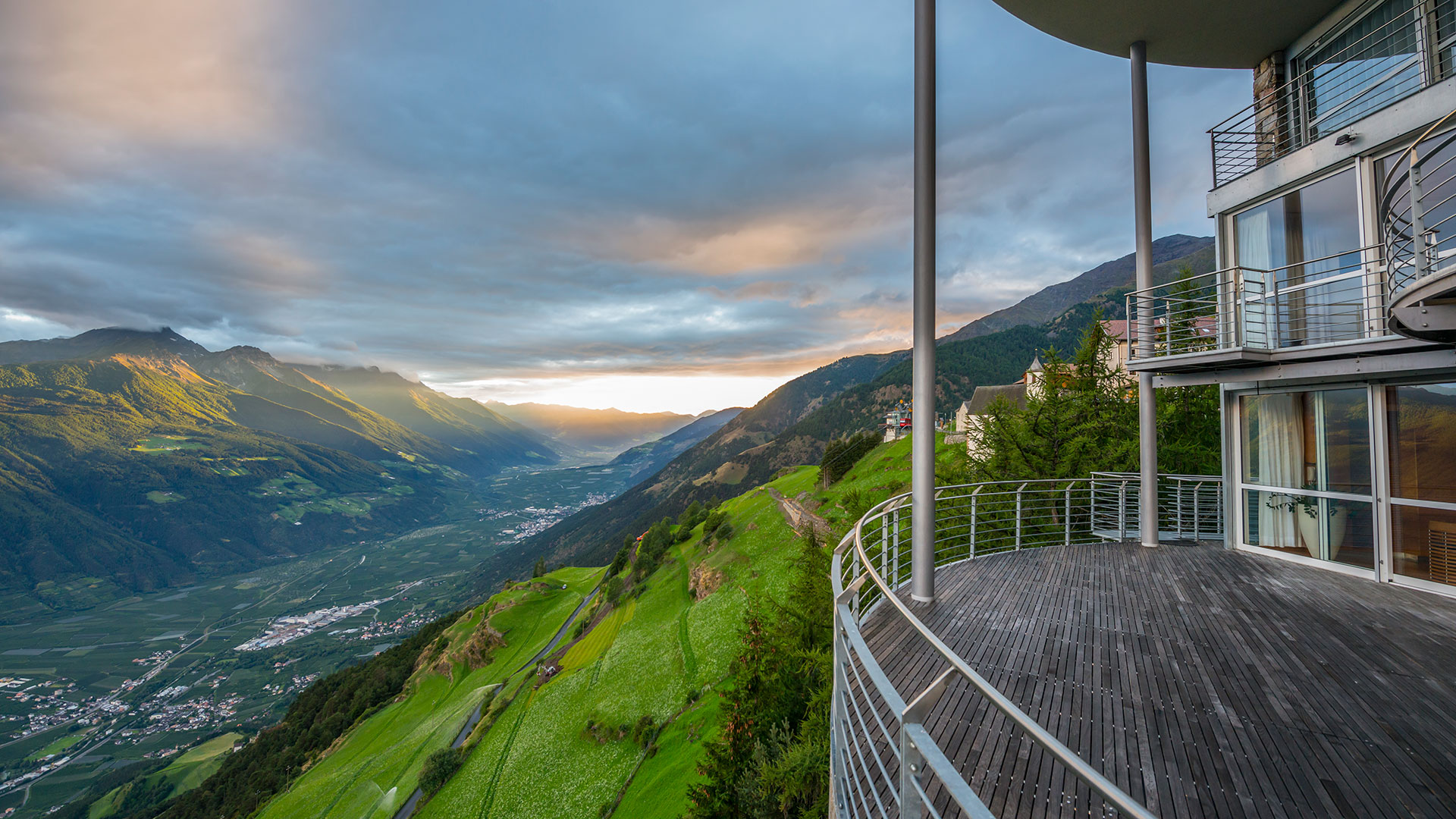

WILLKOMMEN
WELCOME
Welcome to Turm Chalet – one of the most unusual and beautiful holiday accommodations in South Tyrol. Experience unforgettable days here high above Latsch in the lofty heights of Vinschgau's Sonnenberg, amidst the enchantment of nature.
THE HOUSE
Across a cute little bridge lies the Turm Chalet, with a living area of some 500 m²/over 5380 sq ft spread over 4 floors. All levels are connected by a generous staircase located at the back. On the entrance floor are the bedrooms for children or guests, each en-suite and with their own generous terrace balcony. The level below features a spacious home office area; the broad glass frontage reveals views across the Upper Vinschgau all the way to the Swiss mountains, while the smaller windows frame the village of Tarsch like a still-life image of nature. One more level down you will find the main floor, where clear glass allows you to see through the kitchen to the dining space and generous seating area. This then leads either to the light-filled conservatory with its square carpet, or into the cosy living room.
At the very bottom another highlight waits to be discovered: the swimming pool, shimmering green within its stone surround like a captivating 'grotto'. Part of this is the private terrace, completely shielded from view and revealing a fabulous panorama, as well as a sauna area and whirlpool with bar. The overall impression is of a combination of mountain lake and meditation garden.
LIVING QUARTERS
The KITCHEN is fully equipped to the highest standards, with the living/dining area divided by the large wall-mounted wood-fire oven and the fireplace, open on three sides. There is satellite TV, with video/DVD, as well as a stereo system with a good selection of CDs, plus a library.
The wood-panelled LIVING ROOM features a brick fireplace and space for relaxation, as well as a cosy seating area.
SLEEPING QUARTERS
TWO GUEST/CHILDREN'S ROOMS, each with double beds and an additional pull-out bed, the bathrooms resplendent in crystalline white marble with either bathtub or shower.
The towering landscape lends the sheltered BALCONIES at the front a near-meditative quality. Taking in the view here can make you feel like you’re floating.
POOL & SAUNA
There is something of a mysterious mountain-lake feel to the natural concrete pool, 18 metres/nearly 60 feet long, 4 m by 6 m/13 ft by 20 ft wide and between 1.30 and 1.80 m/4 to 6 ft deep, with massage grotto and waterfall. The curved glass panels of the internal terrace retract into the stone wall, allowing the sun and fresh air to enter the 'meditation room'.
The sauna area boasts a Finnish wooden cabin with views into Martell Valley, and the Roman-style steam sauna is entirely clad in the same white Laas marble as the shower walls.
WINTERGARTEN
A light-filled glass cylinder ...
A Bechstein piano waits for aspiring musicians to fill the living-room area with music.
A spiral staircase winds all the way up into the glass pinnacle, where two segments open up automatically, providing access onto the roof, where a ring-shaped rooftop terrace, protected by a stone rim, gives 360-degree panoramic views.
BOOKING
Daniel Rizzi
39021 Latsch – St. Martin
Italien
+39 339 5005218
simone.rizzi@turm-chalet.com
HISTORY
th
OWNER/BUILDER
ARCHITECTURE
Born on New Year's Eve 1944 in Latsch, Walter Rizzi went to primary school there, then on to secondary school at the 'Johanneum' in the village of Tirol, before taking his 'Abitur' final exams at the commercial college in Bolzano. After specialising in Foreign Commerce at Trento College, Rizzi served as CEO of the Ortler fruit cooperative in Latsch between 1965 and 1984, and between 1974 and 1976 also as interim leader of the MIVO fruit cooperative. Between 1972 and 1977 he served as vice chairman (deputy), and since 1977 as chairman of Raiffeisenkasse Latsch. Also: 1982–90 governing board member of the Raiffeisenzentralkasse bank of South Tyrol in Bolzano; 1969–80 borough councillor, deputy mayor; 1974–78 president of the Latsch tourism association; 1978 founder of the fruit firm SELECTA, the SELIMEX trading firm and further import and distribution companies in Germany. Married to Christine Tappeiner on 23 Nov 1971, with whom he had four children, Simone, Lukas, Florian and Daniel. In 2013 he was awarded the Cross of Merit by the state of Tyrol.
PhilosophY
Marrying traditional forms with new technology – here you have a castle at the turn of the third millennium. The house is rooted in the idea of a protective cave, offering sanctuary at the back and only opening up at the front. The huge glass frontage towards the south offers residents not only breathtaking views of the mountains across the way, with the more than 3000 m/9840 ft-high Hasenörl glacier forming the central point of reference, it also serves to capture the warmth of the sun's rays, which permeate the entire house through the circular conservatory stretching across 3 floors. Passive solar energy for the hot water and underfloor heating is gained via the solar panels fitted to the southern flank on the edge of the estate.
In terms of interior design, the motto has been 'less is more' to avoid detracting from the impact of the space. The paintings on the walls are by distinguished Vinschgau artists, with special touches added by the Laas artist Jörg Hofer.
Minimalism also inspired the garden design, where wild herbs, mountain flowers and shrubs frame the pond, in the way of a natural mountain lake, fed by a waterfall, with undressed stones instead of big walls and fences. The bench and table are made from steel and stone rather than rustic wood.
Born in 1955 in Latsch, architect Werner Tscholl studied in Florence. His main interest is New Architecture; his no-nonsense designs are informed by an 'ancient geometric force' shaping modern culture. Tscholl's buildings have been described as inhabitable sculptures. Some of his textbook restorations include Fürstenburg, Schlandersburg and Schlandersberg, his own 'Reichenberg' fortified tower, Reinhold Messner's mountain museum at Siegmundskron Castle (MMM) and many more.
The architect matched the archaic form of the round tower and his own stringent formal discipline and logic with some shrewd ideas. At some 22 m/a good 70 ft high, the cylinder forming the castle keep stands hard by the slope, with the side facing the mountain presenting a massive quarrystone wall broken up only by a few windows resembling arrow slits. It is towards the valley that the building opens up to its full height, with the recessed wall made from glass. The free spaces in front of it form a network of verandas, balconies and viewpoints providing sublime impressions of the natural beauty of the surroundings. The space layout formulates a clever response to the exposed place. Even in the depths of winter, when the valley is sinking towards nightfall, the tower still enjoys bright evening light. This ensures that the rooms lying at the back of the mountain receive their hard-earned light even when the winter sun is lying low.
What is new and unusual here is that the keep consists of a double cylinder: the centre of the rotunda is occupied by a glass barrel with a glass roof. This serves to once more underline the fascinating contrast created by the outer wall's alternating open-and-closed character. The tower protects its residents yet allows them to participate in the giant alpine backdrop even while inside. It is this interplay of internal and external that represents the truly unique and modern spirit of this house.
materials
Local chestnut wood, Sonnenberg stone, white Laas marble sourced in the immediate vicinity, glass and steel.
THE LAND AND ITS PEOPLE
When God had finished making the world, he wanted a reward for all the effort and so granted himself a special wish: to create a perfectly realised little corner of the earth. The result was South Tyrol.
It is the beauty of the natural backdrop, its unusual variety, with the bizarre rocks of the Dolomites, shrouded in myths and legends, mighty glaciers, gentle alpine meadows and dark and mysterious forests which make the heart beat faster. In addition to the climate which, without denying the passing of the seasons, is shaped by the sun and mildness of the southern side of the Alps.
The people who live here not only decorate their villages and towns, they preserve the countryside through attentive care of nature, culture and tradition, and have managed to safeguard the authentic character of home, our 'Heimat', as we say. They are friendly and interested in chatting with visitors; join them for a glass of wine to discover things about the land and its people that you won't find in any of the many books written about South Tyrol.
LANDSCAPE
WHAT TO SEE
Located in the western part of South Tyrol, the Vinschgau stretches some 80 km/50 miles from Merano to the Reschenpass. The valley enjoys an abundance of sun, and there are few rainy days – this is the driest part of the eastern Alps. Forming the southern roof of the Ötztal Alps, the 'Sonnenberg' (Sun Mountain) contributes in a major way to the character of the Vinschgau and is part of the reason why this is one of the most interesting cultural landscapes in the Alps.
Right in the heart of the Vinschgau, some 30 km/a good 18 miles from Merano, Latsch (639 m/2096 ft) is a small town of 4300 souls with a good infrastructure and surrounded by extensive orchards. Lying at an altitude of 1100 metres/3609 feet above Latsch, on a high plateau with a southern exposure, is the mountain hamlet of St Martin im Kofel, with its many alpine farms scattered around the little church. A well-maintained tarmac mountain road leads upwards for 13 km/8 miles via the neighbouring settlement of Kastelbell. The shortest, fastest (8 minutes) and most scenic connection between Latsch and St Martin, however, is provided by the cable car, built with state-of-the-art technology. Up here, where the purity of nature allows you to forget day-to-day concerns, you will find a modern castle – our Turm Chalet.
Vinschgau's Sonnenberg is a very ancient area of human settlement, where numerous prehistoric finds have been made in the past, with more expected in the future. Excavations from the Neolithic and Bronze Age confirm that this area has been settled for at least 4000 years. Imposing testimonies to this are the numerous cup-marked stones dating back to the megalithic culture. These are rocks with artificial depressions in varied shapes, which have a ritual origin.
Right above Kastelbell's main thoroughfare, Kastelbell Castle is still owned by the state and managed and operated by the 'Kuratorium Schloss Kastelbell Gen.m.b.H.' board of trustees. The oldest frescoes in the German-speaking world, from pre-Carolingian times, painted around 770, were discovered in the unassuming little St Prokulus church near Naturns, while the Late Gothic winged altar by Jörg Lederer in the Spitalskirche church in Latsch is a real feast for the eyes.
Right next to it, in the 'Bichlkirche' church, you can admire the Menhir stone dating back to the 3rd millennium BC, which was discovered only recently. The chapel dedicated to Saint Stephen on the Montani Castle hill shelters frescoes from Lombardy and the Swabian area.
KULTUR
The views range over graceful, undulating cultural landscapes with orchards and vineyards shaped by human intervention and carefully looked after. In times past there was no money in the hard up valley for building ostentatious Renaissance or Baroque churches, which is how the Vinschgau managed to preserve so much Romanesque sacred art and architecture. The inhabitants of this ancient cultural landscape between Reschensee lake and Merano enjoy a reputation for being particularly creative folk. The proof lies in the modern architecture of the Vinschgau, combining traditional materials with new ways of seeing.










Rizzi 2015. All rights reserved.
IMPRESSUM/DISCLAIMER


